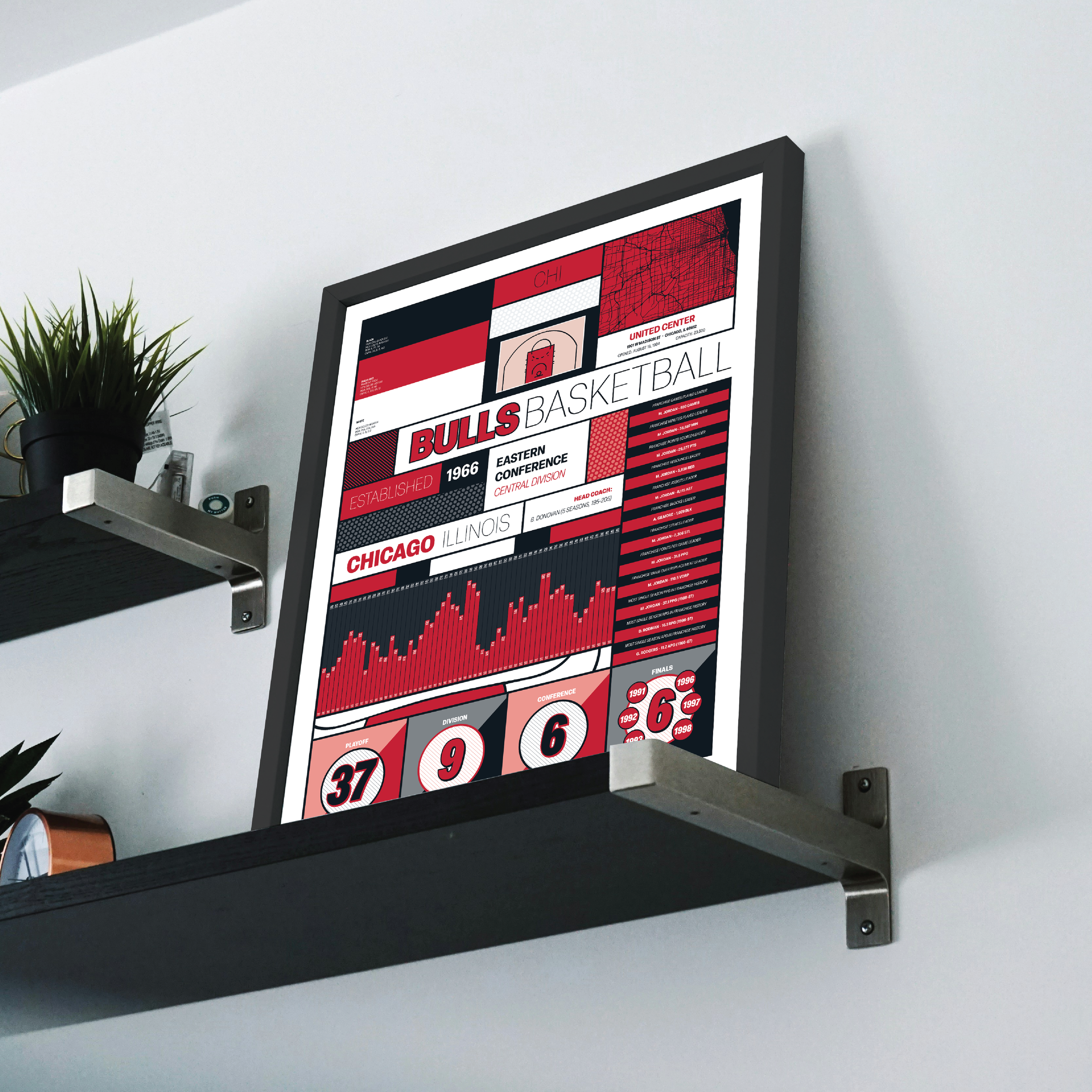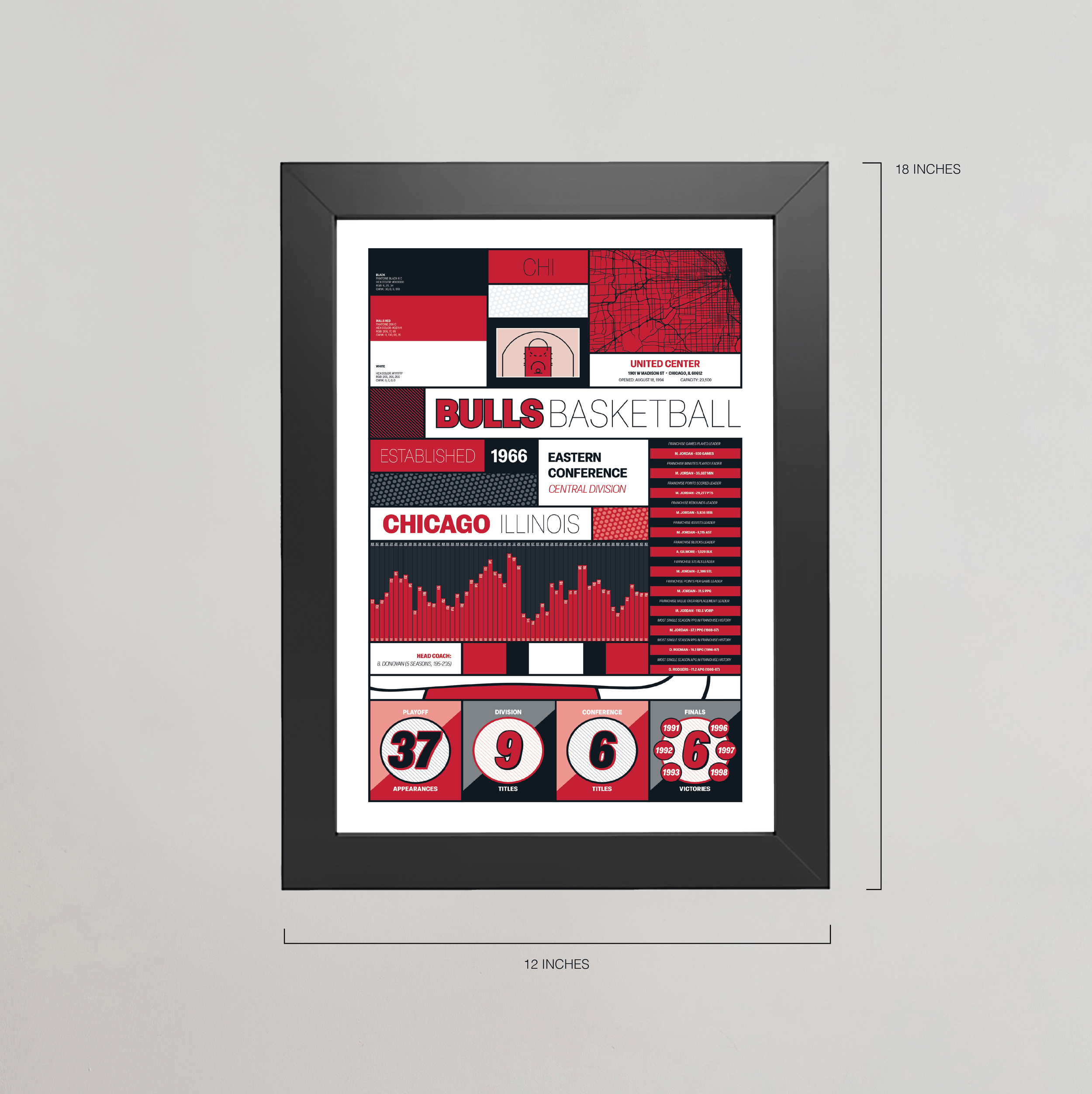







Chicago Bulls "Modern Iconography" Statistical Poster
Sports art doesn’t need to be in-your-face. It can be elegant, stylish, even thought-provoking. These large-scale modern-style prints can certainly fit in a garage or man cave, but they’re most at home in a dining or living room adorned by thoughtful interior design. Created using visual iconography and showcasing historical and statistical data (updated for the 2025-26 season), these posters tell an elaborate story of the legacy of the Bulls in a design-forward manner and will undoubtedly enhance any space you choose to display it in.
The history and legacy of the Chicago Bulls is largely built on the bedrock of one man, Michael Jordan. Established in 1966-67, the Bulls would reach the Eastern Conference Finals twice prior to Jordan’s arrival, but never get any further than that. Beyond some early 1970’s teams led by Chet Walker, the Bulls had proven themselves to be a middling franchise. With the arrival of Jordan in the 1984-85 season, the entire narrative of the franchise was forever altered. Jordan quickly became a scoring machine in his rookie year, averaging 28.2 points per game, building up to 37.1 in year three, and 35.0 in year four. Continuing to average 30+ per game into the late 80’s, Jordan would get stonewalled by the Bad Boy Pistons come playoff time every year, and the narrative began to build that Jordan was a great scorer, but not a winner. The Bulls drafted Scottie Pippen in 1987-88, brought in former Knicks tough guy Phil Jackson to be the head coach in 1989-90, and with Jordan taking a mini-half step back on ball domination suddenly gelled and became a behemoth. They would go on to win three straight NBA Finals from 1991-1993. Jordan would famously retire (or be suspended for gambling, some may say?) for two years, but would come back and win three more Finals from 1995-1998. The 1996-97 team especially would go down in history, breaking the record for wins in a season and amassing an awesome 69-13 record and rolling to the championship over the Utah Jazz in the NBA Finals. The 1990’s would end with the dismantling of the team, perhaps a year or two early. The team would have definable eras into the new century — There were the Baby Bulls, the Derek Rose MVP season and subsequent fall from elite stature, the Joakim Noah/Jimmy Butler/Tom Thibodeau punch-you-in-the-mouth era, and now the Zach LaVine/DeMarr DeRozan era… But none of these teams have ever captured the greatness that those Jordan Bulls did. Frankly, no team in American sports has ever truly captured that greatness or notoriety before or since, either.
Free Shipping on All Items — The price you see is what you spend.
Printed on 10.3 mil (0.26 mm) matte paper. Framed options include mounting hardware.
Sports art doesn’t need to be in-your-face. It can be elegant, stylish, even thought-provoking. These large-scale modern-style prints can certainly fit in a garage or man cave, but they’re most at home in a dining or living room adorned by thoughtful interior design. Created using visual iconography and showcasing historical and statistical data (updated for the 2025-26 season), these posters tell an elaborate story of the legacy of the Bulls in a design-forward manner and will undoubtedly enhance any space you choose to display it in.
The history and legacy of the Chicago Bulls is largely built on the bedrock of one man, Michael Jordan. Established in 1966-67, the Bulls would reach the Eastern Conference Finals twice prior to Jordan’s arrival, but never get any further than that. Beyond some early 1970’s teams led by Chet Walker, the Bulls had proven themselves to be a middling franchise. With the arrival of Jordan in the 1984-85 season, the entire narrative of the franchise was forever altered. Jordan quickly became a scoring machine in his rookie year, averaging 28.2 points per game, building up to 37.1 in year three, and 35.0 in year four. Continuing to average 30+ per game into the late 80’s, Jordan would get stonewalled by the Bad Boy Pistons come playoff time every year, and the narrative began to build that Jordan was a great scorer, but not a winner. The Bulls drafted Scottie Pippen in 1987-88, brought in former Knicks tough guy Phil Jackson to be the head coach in 1989-90, and with Jordan taking a mini-half step back on ball domination suddenly gelled and became a behemoth. They would go on to win three straight NBA Finals from 1991-1993. Jordan would famously retire (or be suspended for gambling, some may say?) for two years, but would come back and win three more Finals from 1995-1998. The 1996-97 team especially would go down in history, breaking the record for wins in a season and amassing an awesome 69-13 record and rolling to the championship over the Utah Jazz in the NBA Finals. The 1990’s would end with the dismantling of the team, perhaps a year or two early. The team would have definable eras into the new century — There were the Baby Bulls, the Derek Rose MVP season and subsequent fall from elite stature, the Joakim Noah/Jimmy Butler/Tom Thibodeau punch-you-in-the-mouth era, and now the Zach LaVine/DeMarr DeRozan era… But none of these teams have ever captured the greatness that those Jordan Bulls did. Frankly, no team in American sports has ever truly captured that greatness or notoriety before or since, either.
Free Shipping on All Items — The price you see is what you spend.
Printed on 10.3 mil (0.26 mm) matte paper. Framed options include mounting hardware.







